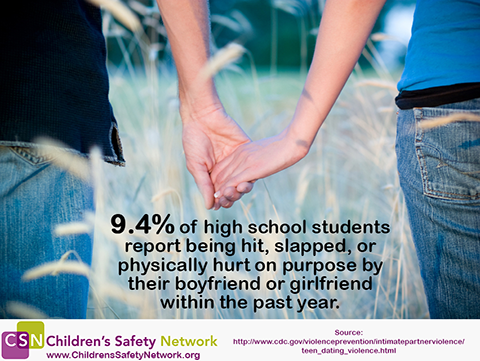
In recognition of Congress’ designation of February as Teen Dating Violence Awareness Month, CSN is pleased to provide this blog post centered around the critical issue of teen dating violence.
In the past 12 months, have you been hit, slapped, or physically hurt on purpose by your boyfriend or girlfriend? According to the CDC’s 2011 Youth Risk Behavior Survey, nearly 10 percent of teenagers – 1 in 10 youth – said “Yes.” Looking at the research, that number can jump as high as 35 percent, depending on the teen populations being studied; how abuse is defined; if teens are asked about their full or recent dating history; and whether researchers are measuring both victims and perpetrators.
With such prevalence among teens, it’s important to examine the long-term impact of teen dating violence (TDV). In a study published in Pediatrics, 5,681 12- to 18-year-old adolescents with dating experience were interviewed to assess the existence of TDV in their relationships. Five years later, researchers followed up with the participants to determine the effects of that reported dating violence. The survey results showed that both genders displayed significant adverse outcomes. The females in the study who had been victims of TDV reported “heavy episodic drinking, depressive symptomatology, suicidal ideation, smoking, and intimate partner violence (IPV) victimization.” In follow up interviews, the male participants who had been victims of TDV reported “increased antisocial behaviors, suicidal ideation, marijuana use, and IPV victimization.” It is clear that teen dating violence is a threat to public health long after the signs of physical violence fade.

Teen Dating Violence Rooted in Early Childhood
To address the public health implications of TDV, it’s important to study its roots in early childhood. Research shows that family environment plays an important role in influencing the interpersonal relationships of teenagers. In “The Development of Dating Violence: What Doesn’t Develop, What Does Develop, How Does It Develop, and What Can We Do about It?”, Debra Pepler finds that “children who grow up in families in which there is violence have daily behavioral lessons on the use of aggression in relationships.” Not only does the existence of violence in a family influence a teen’s future dating habits, but theattitudes toward violence and the gender of the parental aggressor can play a role in influencing the likelihood that children will be future victims and perpetrators of TDV. In addition to the adverse impact of witnessing interpersonal violence in the home, research shows that teens in certain special populations can be at greater risk for violence, including: high school students with disabilities,gang affiliations, and signs of depression.
Promising Practices to Addressing TDV
Despite the clear signs that TDV poses significant health risks to adolescents, according to “Adolescent Dating Violence: A National Assessment of School Counselors’ Perceptions and Practices,” a 2012 study published in Pediatrics, schools did not find TDV to be a high-priority issue and few schools had resources or training for staff to effectively address the issue. In an effort to share available evidence-based resources, the Children’s Safety Network’s 2012 fact sheet Teen Dating Violence as a Public Health Issue, highlights three interventions – Safe Dates, the Youth Relationships Project, and the 4th R Curriculum – that have been designated promising practices for reducing teen dating violence behavior. As a companion piece to that publication, CSN’s Teen Dating Violence Prevention Guide compiled data, research articles, updates on policy and legislation, evidence-based prevention strategies, tools for program planning, and a list of national organizations that address TDV. As an update to that resource, we’ve collected recently published resources and research and linked to them at the end of this post. By raising awareness about the negative impact of TDV and looking closely at available resources and evidence-based interventions, we can begin to move the needle in eliminating this important public health problem.
CSN Resources
- How To Recognize Signs of Teen Dating Violence - A WBUR Interview with CSN's Sally Fogerty
- Children’s Safety Network Fact Sheet: Teen Dating Violence as a Public Health Issue
- Children’s Safety Network Special Newsletter: Teen Dating Violence Prevention Resource Guide
Teen Dating Violence Awareness Month Resources
- Teen Dating Violence Awareness Month
- Love is Respect
- Break the Cycle
- February is National Teen Dating Violence Awareness & Prevention Month from the CDC
New Resources
- Dating Violence Among Adolescents: Resource Brief | MCH Library
- Teen Dating Violence: Resources for Teens and Parents | CBS News
New Research
- Adolescent Beliefs About the Acceptability of Dating Violence: Does Violent Behavior Change Them?, 2012
- Adolescent Dating Violence: A National Assessment of School Counselors’ Perceptions and Practices, 2012
- Associations among Depressive Symptoms, Dating Violence, and Relationship Power in Urban, Adolescent Girls, 2012
- Dating Violence and Associated Health Risks among High School Students with Disabilities, 2012
- Dating Violence Prevention Programming: Directions for Future Interventions, 2012
- The Development of Dating Violence: What Doesn’t Develop, What Does Develop, How Does it Develop, and What Can We Do About It?, 2012
- Expect Respect Support Groups: Preliminary Evaluation of a Dating Violence Prevention Program for At-Risk Youth, 2012
- Importance of Gender and Attitudes about Violence in the Relationship between Exposure to Interparental Violence and the Perpetration of Teen Dating Violence, 2013
- Inter-Partner Violence in the Context of Gangs: A Review, 2012
- Patterns of Dating Violence Across Adolescence, 2012
- The Peer Context and the Development of the Perpetration of Adolescent Dating Violence, 2012
- Perpetration of Teen Dating Violence in a Networked Society, 2013